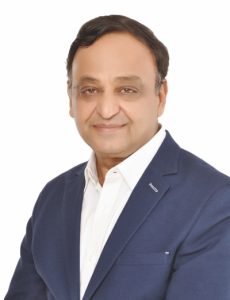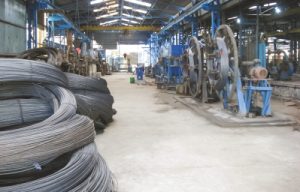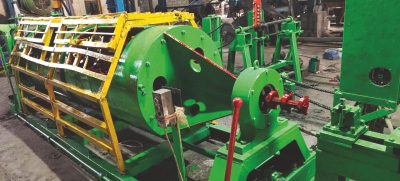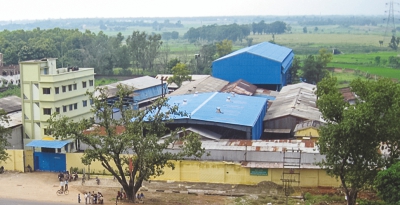
Miki Wire Works Private Limited is a trusted name in the steel wire industry, with a vision to adapt their processed product line to keep pace with new concepts and products. The company’s manufacturing units are present in four locations, with their mother plant in Ranchi, Jharkhand, and the rest in Visakhapatnam, Bangalore and Nagpur, respectively. The plant has a current capacity of 1 lakh tonnes per year, out of which they utilize 85 percent. In a recent conversation with Wire & Cable India, Mr. Mahesh Poddar, who also happens to be former member of Parliament & SWMAI past president Chairman, Miki Wire Works Private Limited, shared the company’s overview, manufacturing plants, sectors catered, the organization’s recent developments, his views on the current state of the steel wire industry, the Indian government’s support, challenges faced and how to overcome them.
Wire & Cable India: Could you please take us through the business journey, milestones and achievements of your company?
Mahesh Poddar: Miki Wire Works Private Limited, Ranchi has emerged as a multifaceted, well- diversified and a professionally managed company. In a span of over 40 years, the Miki Wire Group has grown many folds; our wings have now spread to all corners of India. With four manufacturing units spread across India, Miki Wire is a trusted name in the steel wire industry, owing to its superior quality and supply chain management. We now cater to the 20% of the railway concrete sleeper wire requirement of the Indian Railways. Our continued investments in superior technology consistently push products to the highest quality standard. We have consistently been learning and reinvesting back into the company. We make sure to focus on relevant products, demanded by our consumers.
Watch: RR Kabel | Solar Cables | Solar Plant | Renewable Energy
WCI: Describe your infrastructure and manufacturing setup for the steel wire sector along with their manufacturing capabilities and total production capacity.
MP: Our production facilities are present in four locations, namely, Ranchi, Visakhapatnam, Bangalore and Nagpur. Most of these plants cater to their nearby areas, but our Ranchi plant, which is our mother plant, caters to consumers from Agarthala to Jammu. We are mainly catering to two sectors, one is concrete sleeper reinforcement for the Railways and the second is PCC reinforcement. We have recently started making automotive spring wire and LRPC strands. In terms of capacity, we currently have a capacity of 1 lakh tonnes per year, out of which we are achieving about 85 percent of the capacity. Our other wires are for rolling shutters springs, umbrella ribs, fibre wire, etc.
WCI: What have been the recent developments at your organization and what are your future growth plans?
MP: It was my personal ambition to produce steel wire through a green route. Recently, we have also started to produce wires with the dia of 12mm or 14mm, high carbon grades; drawing through the mechanical decaling route. We also introduced green induction heating for stress relieving of the wire, eliminating lead and Furnace oil as heat transfer medium to ensure consistent quality. Additionally, we are constantly looking out and experimenting with the products, which reduce power requirements and create high quality products. Fortunately, we have access to wire rods from most of the steel producers in the country, allowing us to continue with our innovative ideas. We are planning to produce more spring wires and specialty wires. We have also decided to improve the efficiency of our existing facility, through cutting down the cost and modernizing the machines, so that we remain efficient and our profitability is protected though it is a “decades“ old MSME unit.
WCI: Please share your views on the Indian vis-a-vis the global steel wire industry. What is the role of the Indian government in the growth of this sector?
MP: Globally, the steel industry’s growth naturally propels the growth of the steel wire industry. This refers to the fact that if the steel industry grows manifold, the steel wire industry will also be growing. India has a stable and ambitious government, with clear goals. The Indian government has set various targets following strict timelines, and one of the major targets set by the government is that India will become a developed nation by the time India completes 100 years of independence. In order to achieve this feat, every industry has to take major leaps, in terms of both volume and technically niche products. Talking specifically about the steel industry, globally economic development is also matched with the per capita demand of steel of a particular country or economy. Today we can see that China is producing nearly half of the world’s steel, whereas India’s production is lagging behind. However, the government has now set a steel production goal for 300 million tons by 2030, which further involves sub-targets like 55 million tons of special steel. In addition to this, the way our industry’s growth is mostly driven by domestic demand, this seems like an achievable goal, despite global slow- downs. In order to achieve this goal, the government is providing major support through PLI schemes, promotional or supportive activities, opening up of mining activities, major amounts being spent on infrastructure, power sector reform and growth particularly through solar power availability in an ever-growing quantum. These are a few things which emphasize the seriousness of the growth of the steel industry. We have witnessed how China has taken a big leap in terms of production, from 2004 to 2014. I can visualize similar growth in India in the next few years.
Also Read: Prestress Steel to Establish Cold Ribbed Manufacturing Plant with 20,000 TPA Production Capacity in Silvassa
WCI: What are the major ongoing challenges in the Indian steel wire industry?
MP: One major challenge is that ever since the country’s independence, no major investment and technology upgradation has been made in the steel wire industry. This resulted in many organized, big factories being closed down and many small medium-sized enterprises coming up and witnessing significant growth. Today, some of the major steel producers are taking help from smaller enterprises for steel wire production through conversion routes.
In this way they have the advantage of raw material, brand and a cheaper working environment of small scale factories. Another issue is that after free trade policy was introduced, some liberal imports took place in the steel sector. This prompted Western India to grow faster in the steel wire industry and the Eastern region, which had better raw material availability, lagged behind. In the meantime, the emergence of the secondary or smart steel sector started, with pockets located in places like Raipur and Durgapur. These small mills produced steel through induction or alternative routes, were cheaper and also invested in downstream steel wire making. Though they did not invest in making very high end products, they took over almost 60-70% of the commercial domestic market.
North has the largest consumption, while south has very small capacity. We also face the issue of poor exports, stunting the growth of the domestic market. However, the secondary sector consolidated its position in TMT bars also and almost 65-70% of the market share for TMT bars in India is due to the secondary sector. However, in many developed countries, the usage of TMT bars is reducing and being replaced by wire mesh and deformed wires, which can pose another opportunity, if this trend comes to India. The growing power cost to the small and medium industries in many states is also a cause of worry. Multiple PLI proposals have been put before the government, but many of those companies will not invest that amount of money and will eventually not be eligible for PLI. Another major challenge is the capacity of individual plants and the overall capacity of the steel wire industry, which is far lesser than China. One of the reasons behind this is poor and irregular availability of wire rod and its unstable pricing. Second reason is that the use of steel wire is still not very popular. Third reason is that the spectrum of steel wire products which are made to be exported are still insignificant. Moreover, steel producers, particularly the bigger ones, have not taken any initiative to promote downstream industry. If we have a target to produce more steel and more wire then simultaneously we have to look for areas with higher demand for the product, within India as well as outside. Though the government has taken initiative to provide raw materials, that is steel wires, at the export pricing somehow it has not become popular as of yet or even taken off .
WCI: How can these challenges of the industry be addressed? How is your company contributing towards this transition?
MP: Challenges come with opportunity. I would suggest that the government allow a small window for actual users so that they can import wire rods for their own consumption from across the globe. These wires can be consumed either for domestic purposes or be processed, downstreamed and re-exported. Apart from that, I would suggest that manufacturing space be provided near the power generating stations where the losses of the electricity distribution company are not loaded, so cheaper power is available to the industry. I believe that stable pricing, easy availability of wire rods either from domestic sources or global players can also be supported by the government. The government should also set a more suitable minimum threshold limit for PLI investment required and fix the scheme according to that, apart from capacities promoting additional capacities. We at Miki have gradually been shifting from low-end commodity products like binding wire to automotive spring wire, LRPC wire, and higher end wires.
Moreover, we have been modernizing our plants for efficient functioning. Our group has also branched out to meet local needs so that we meet the demand on a local basis, as well as source raw materials from nearby. This is how we have been overcoming these hurdles and growing. We believe that the industry must remain hopeful, as the industry is finally showing signs of overcoming the negative period we were going through. I am sure the government’s liberal policy to commercially mine the minerals, non tariff barriers on the finished wires, wire products, setting up separate export targets for steel wire sector out of engineering goods export, will help the industry as well as the nation.







